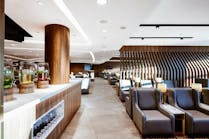Pullquotes:
“If you're able to bring in recognizable concepts that people will gravitate toward, it generates more revenue, but also a perceived quality and value.”
John Reeb, senior principal property manager, San Francisco International Airport
"It's worth the effort to tailor the concessions assortment to the destination."
Adrian Songer, chief of Aviation Business and Revenue Development, Miami International Airport (MIA)
“We need keep up with what’s current, but also anticipate what will be hot in the future.”
John Reeb, senior principal property manager, San Francisco International Airport
Consumer confidence is the benchmark of an economy’s growth, and the same is used when measuring airport concessions’ success. From branding with famous chefs and local appeal, to services like walking paths and spas, even upscale pet boarding, airport concessions are making a statement in consumer confidence, and it’s a big one. It’s a way to build revenue, but also consumer loyalty and following in today’s competitive market.
John Reeb, a senior principal property manager at San Francisco International Airport (SFO), says airports are not quite at the stage where they are selling the destination, but that is coming. Frequent fliers know which airports have certain amenities, and with more people booking their own flights, "if they know their favorite steakhouse is at Hartsfield-Jackson International in Atlanta, they will book through Atlanta," he says matter-of-factly.
John Greer from Minneapolis-St. Paul International Airport (MSP) agrees. This assistant director of Concessions and Business Development reports the industry is definitely heading in that direction, and on some levels, is already there.
To become the airport of choice, branding is playing a large role in developing an attractable and sustainable concessions program. But it needs to be balanced with maintaining the regional flair travelers expect when passing through their favorite cities.
Local Branding Pays
Branding is hot in today's airport concessions, says Reeb. From famous chefs like Cat Cora to high-end designers such as Michael Kors, names sell. In 2004, his San Francisco airport moved from 30 years of a master concessionaire model to direct leasing with local restaurateurs. “We went to a quality program rather than the cookie-cutter, snack bar, traditional one,” he explains.
And in the first true year-to-year comparison (2003 versus 2006), concessions’ revenue jumped nearly 112 percent, he adds.
Airports in areas known for their local cuisine can capitalize on that, Reeb notes. The SFO home run on this concept came with its Napa Farms Market, the centerpiece of Terminal 2’s food program. This spinoff from the city’s Ferry Building Marketplace offers passengers a place to grab a last-minute bottle of wine, fresh produce or quick bite as they head out of town. Local Food Network Chef Tyler Florence has a stand in the market, as does a local wood-fired pizza place. Gourmet cupcakes and organic coffee put the frosting on the cake for this first-of-its-kind airport concession. “It has been a huge success,” says Reeb, who says more of the same are bound to pop up in other airports around the country. “The first month it was open they had no idea how successful it would be. The market was running out of stock by Noon, which was a good problem to have.”
Local branding runs even stronger at SFO. Perry’s, a long-standing bar and grill in the city, and the city’s famous Buena Vista Café, serve passengers a local experience as well as good food. Brewer Gordon Biersch brings its renowned beer and garlic fries to the facility, says Reeb.
“If you're able to bring in recognizable concepts that people will gravitate toward, it generates more revenue, but also a perceived quality and value,” Reeb explains. The average airport dwell time is minimally 1 ½ hours, and he feels a movement is being made toward quality over quantity.
Know Thy Customer
An Irish pub is being built at Miami International Airport (MIA). Adrian Songer, MIA chief of Aviation Business and Revenue Development, says he didn't come up with the idea; the owner of its Cuban restaurant did.
While MIA is well-known for its Latin flair through dining, shopping and décor, Songer says diversity remains an important element in airport concessions development. Regional flair is good, but the travelers walking through an airport represent stops from around the world.
For example, Gate D8 will once again host the British travelers this summer. Songer explains there's a profit to be made if Johnnie Walker and scones are available near the gate. "It's worth the effort to tailor the concessions assortment to the destination people are traveling," he says.
The average dwell time at MIA is 2.5 hours but for some travelers it may be far less than that, Songer adds, making it important to offer both quick-serve and sit-down restaurant choices. And there needs to be some variety in both. Some people want the known quality of a Wendy's, while others prefer the regional flavor of its Cuban restaurant, Kuva. The retail side of the spectrum is no different. Songer says that especially in high tourist areas, an airport wants to provide the "good, better and best offerings. Success comes with a blend and balance."
The blend and balance is met by relying on the concessions experts. When the Cuban restaurateur developed the idea for the Irish pub, Songer says he never would have thought to put that in Miami, "but that's their business.”
Knowing what the customer wants is key to a profitable and recognized concessions’ program. Whether working with a developer, master concessionaire or direct lease program, communicating and developing a positive relationship with tenants is a must to maintaining consistency and quality in the program, Reeb explains.
“There are times when a tenant is struggling and even though bound by lease, there are ways we can help them,” he adds. Walking the airport daily and hosting regular meetings keeps executives and decision-makers in tune with what the market demands. “We need keep up with what’s current, but also anticipate what will be hot in the future,” Reeb says.
MSP has found great benefit in teaming with St. Paul’s Hamline University’s MBA students to keep tabs on what’s hot and what’s not. The students do survey work for the airport as part of their final projects. “They talk to passengers at different times of the day, days of the week, and interview them,” Greer says. “The passengers are really open to speaking with the students, especially once they learn it’s for a degree project.”
Greer explains that each quarter, a new group surveys on a new topic. A recent one was on local brands versus national. When it comes to food, the MBA students found travelers responses split down the middle. “Half said they really wanted to see that local flair and try things they couldn’t otherwise, while the rest said they wanted to eat where they were familiar with the offerings.”
He says that in all the RFPs, MSP incorporates some localness. The airport wants to tell visitors through décor, customer service and concessions offerings that they are in Minnesota and the friendly Midwest. Greer says he and his staff are very involved with their vendors, and talk about menus, product offerings on a regular basis. A Customer Service Action Council also meets monthly to discuss what “we can do to raise the bar,” he says. “It’s been really beneficial to the program.”
With 23 years in at MIA, Songer says he loves his job and talking about concessions development. While Miami has grown its program through mere space (more than 2 million square feet in his time), it also has grown in notoriety. Songer feels he and his team are doing something right, since sales have increased significantly every year. He gives much credit to the "excellent" vendors who listen when their customers ask if they do, or why they don't, offer certain options. They know the client better than anyone, and it shows in the awards the airport has won for its concessions program.
Capture Consumer Comforts
MSP has three spas (two with hair salons), and all are successful. The availability of consumer comforts is becoming increasingly common in airport terminals around the globe. In the United States, walking paths, USB charging stations, kids' high-tech interactive play areas and even animal services are the new expected amenities for air travel.
Greer acknowledges that having something for everybody is not easy. While some want to just eat, others want to just shop and still others want none of the above. “That’s why we’ve looked at having services here,” he says about MSP.
MSP’s 1.4-mile walking path was developed through collaboration with the American Heart Association, while yoga is a popular relaxation option in SFO’s Terminal 2.
The other big program at MSP has been at the airport’s G Concourse, where Greer has worked with OTG Management to develop new direct-to-gate conveniences. Instead of the normal gate waiting chairs, restaurant-style tables are in their place, with iPads placed at each one. Guests can order food, gifts, etc. from nearby concessionaries directly off the iPad and wait until the order arrives at their table.
Greer says that it attracts those who want to get to their gate and feel assured they are in the right place and won’t miss their flight. Delta Air Lines is a partner in this program, and is bringing it to other airports. “It has been really, really successful and we’ve gotten a lot of compliments with it,” he says.
The Now Boarding pet facility on airport property is another service that’s receiving much acclaim from both the airport and traveling community. It’s open 24 hours a day so that if individuals want to pick up their pets after their 10 p.m. flight lands, they can. It’s also a place for travelers to park their vehicle, and be shuttled to the airport terminal and back.
Greer says that whether a business, leisure or in-between traveler, everyone wants something different during their time at an airport. With a well thought-out mix of famous brands, local and national favorites, and customer services, a facility can be one sought out the next time a passenger is booking flights.
Bio: Jen Bradley, owner of Bradley Bylines, is a freelance writer based in East Troy, Wis. She specializes in writing about aviation issues and can be reached via her website, www.bradleybylines.com
.



